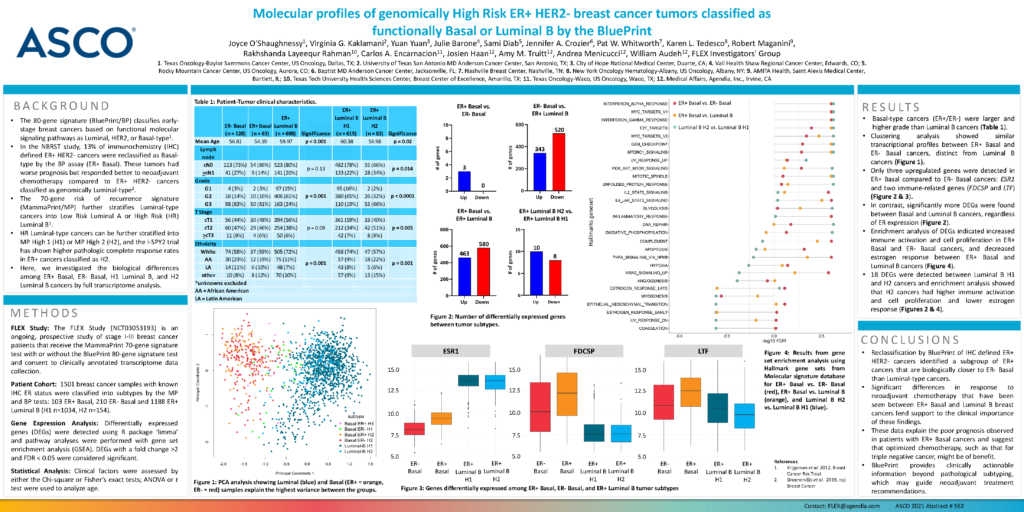PUBLICATION: ASCO 2021
Authors
Joyce O’Shaughnessy1, Virginia G. Kaklamani2, Yuan Yuan3, Julie Barone4, Sami Diab5, Jennifer A. Crozier6, Pat W. Whitworth7, Karen L. Tedesco8, Robert Maganini9, Rakhshanda Layeequr Rahman10, Carlos A. Encarnacion11, Josien Haan12, Amy M. Truitt12, Andrea Menicucci12, William Audeh12, FLEX Investigators’ Group13
Background
- The 80-gene signature (BluePrint/BP) classifies early-stage breast cancers based on functional molecular signaling pathways as Luminal, HER2, or Basal-type1.
- In the NBRST study, 13% of immunochemistry (IHC) defined ER+ HER2- cancers were reclassified as Basal-type by the BP assay (ER+ Basal). These tumors had worse prognosis but responded better to neoadjuvant chemotherapy compared to ER+ HER2- cancers classified as genomically Luminal-type2.
- The 70-gene risk of recurrence signature (MammaPrint/MP) further stratifies Luminal-type cancers into Low Risk Luminal A or High Risk (HR) Luminal B1.
- HR Luminal-type cancers can be further stratified into MP High 1 (H1) or MP High 2 (H2), and the I-SPY2 trial has shown higher pathologic complete response rates in ER+ cancers classified as H2.
- Here, we investigated the biological differences among ER+ Basal, ER- Basal, H1 Luminal B, and H2 Luminal B cancers by full transcriptome analysis.
Methods
FLEX Study: The FLEX Study (NCT03053193) is an ongoing, prospective study of stage I-III breast cancer patients that receive the MammaPrint 70-gene signature test with or without the BluePrint 80-gene signature test and consent to clinically annotated transcriptome data collection.
Patient Cohort: 1501 breast cancer samples with known IHC ER status were classified into subtypes by the MP and BP tests: 103 ER+ Basal, 210 ER- Basal and 1188 ER+ Luminal B (H1 n=1034, H2 n=154).
Gene Expression Analysis: Differentially expressed genes (DEGs) were detected using R package ‘limma’ and pathway analyses were performed with gene set enrichment analysis (GSEA). DEGs with a fold change >2 and FDR < 0.05 were considered significant.
Statistical Analysis: Clinical factors were assessed by either the Chi-square or Fisher’s exact tests; ANOVA or t test were used to analyze age.
Results
- Basal-type cancers (ER+/ER-) were larger and higher grade than Luminal B cancers (Table 1).
- Clustering analysis showed similar transcriptional profiles between ER+ Basal and ER- Basal cancers, distinct from Luminal B cancers (Figure 1).
- Only three upregulated genes were detected in ER+ Basal compared to ER- Basal cancers: ESR1 and two immune-related genes (FDCSP and LTF)(Figure 2 & 3).
- In contrast, significantly more DEGs were found between Basal and Luminal B cancers, regardless of ER expression (Figure 2).
- Enrichment analysis of DEGs indicated increased immune activation and cell proliferation in ER+ Basal and ER- Basal cancers, and decreased estrogen response between ER+ Basal and Luminal B cancers (Figure 4).
- 18 DEGs were detected between Luminal B H1 and H2 cancers and enrichment analysis showed that H2 cancers had higher immune activation and cell proliferation and lower estrogen response (Figures 2 & 4).
Conclusion
- Reclassification by BluePrint of IHC defined ER+ HER2- cancers identified a subgroup of ER+ cancers that are biologically closer to ER- Basal than Luminal-type cancers.
- Significant differences in response to neoadjuvant chemotherapy that have been seen between ER+ Basal and Luminal B breast cancers lend support to the clinical importance of these findings.
- These data explain the poor prognosis observed in patients with ER+ Basal cancers and suggest that optimized chemotherapy, such as that for triple negative cancer, might be of benefit.
- BluePrint provides clinically actionable information beyond pathological subtyping, which may guide neoadjuvant treatment recommendations.
1. Texas Oncology-Baylor Sammons Cancer Center, US Oncology, Dallas, TX; 2. University of Texas San Antonio MD Anderson Cancer Center, San Antonio, TX; 3. City of Hope National Medical Center, Duarte, CA; 4. Vail Health Shaw Regional Cancer Center, Edwards, CO; 5. Rocky Mountain Cancer Center, US Oncology, Aurora, CO; 6. Baptist MD Anderson Cancer Center, Jacksonville, FL; 7. Nashville Breast Center, Nashville, TN; 8. New York Oncology Hematology-Albany, US Oncology, Albany, NY; 9. AMITA Health, Saint Alexis Medical Center, Bartlett, IL; 10. Texas Tech University Health Sciences Center, Breast Center of Excellence, Amarillo, TX; 11. Texas Oncology-Waco, US Oncology, Waco, TX; 12. Medical Affairs, Agendia, Inc., Irvine, CA; 13. FLEX Investigators’ Group



